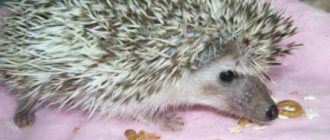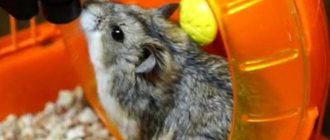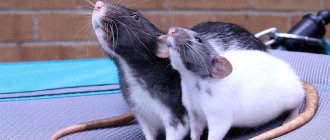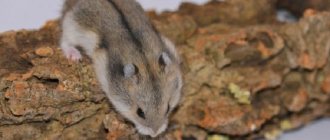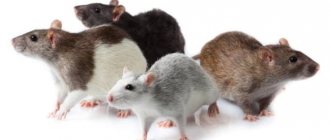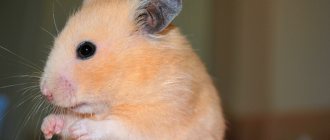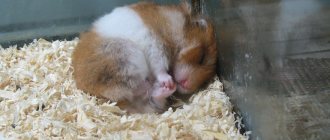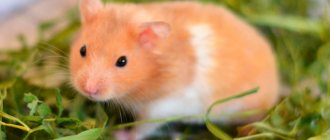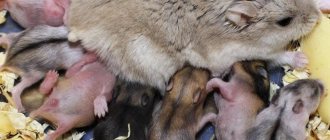- home
- Kinds
31.03.2018
A small, nimble, cheerful and active creature is a representative of the dwarf rodent species Campbell's hamster. This baby will bring his owners a lot of joy, he is unpretentious in daily maintenance and does not require special care. However, some rules of keeping and feeding will have to be strictly followed.
Description of Campbell's hamsters
How can you describe this cute animal?
A small, furry little guy. These dwarf animals will give their owners a sea of positivity and love. It is very important to know the distinctive features of these animals. If you don’t want to make a mistake when choosing a pet, read carefully. Often people buy a pet without thinking about the breed and its inherent habits and habits. Campbells are nimble, active animals. How they are very similar to their relatives - the Dzungarians. People unfamiliar with hamster breeds are unlikely to be able to distinguish a Campbell's hamster from a dwarf hamster. But this can be done by knowing the distinguishing characteristics of the Campbell breed. Among them:
- predominance of golden, brownish or delicate amber color;
- miniature ears;
- lack of fur on the feet;
- readiness to defend one's honor in a duel (more on this later).
Status and preservation [edit]
This hamster is listed as Least Concern by the International Union for Conservation of Nature (IUCN). The population and range size are large and there are no known serious or widespread threats to the species. However, due to increasing livestock numbers in distribution areas such as the Central Asian steppes, some burrows are at slight risk of collapse. In dry areas of distribution, the decrease in the number of water sources is also not a major concern. These hamsters are kept in protected areas. [1]
Appearance of Campbell's hamster
Campbell's hamsters come in one color or a variety of colors. The most common color is agouti. Take a look at this photo:
Agouti, it’s something like this (Altai type)
The coat is predominantly sandy-gray in color, the tummy is similar to the color of milk. There are animals of a monochromatic sand color. These dogs do not have a dark stripe on the back, but there are white spots throughout the fur and a light chin. This color is very popular among breeders and lovers of this breed. It's called "self".
Interesting fact : by color you can determine in which region a hamster lives.
The color of the Campbell breed hamster living in the Altai region has more gray color (see photo above), while those living in the steppes of Mongolia have more brown color with a yellowish tint. Here, for example, is a photo of a Mongolian Campbell:
Campbell's Mongolian hamster
Where there is more sand and earth, that is, the soil is brown, in the course of evolution, brownish-colored animals more often survived, since they merged with the earth. It was harder to notice them. They gave brown offspring. In Altai there are more stones and rocks, that is, more gray colors, which is why gray animals predominate there.
In addition to color, there are differences in size, ear shape, head shape and even smell. Significant differences in character. This is due to natural enemies found in the natural habitat of Campbell hamsters. For example, it is believed that animals from the Altai region are less aggressive in nature than their Mongolian counterparts.
Campbell's hamster photo
At the end of our story - photographs of Campbell's hamsters (photos are clickable, there is a cross in the upper left corner to close the gallery)
Breeds of hamsters Wild hamster Karbacher - photo, description of how the wild hamster lives in the wild (aka Karbacher, aka forest or field hamster 6 11.2k.
General information L. Abelyan: Hamster, good-natured fatty - text, music and soundtrack A cheerful, kind children's song about a hamster, fatty 2 10k.
Nutrition Can hamsters eat watermelon, watermelon seeds and watermelon rinds Do you think hamsters can eat watermelon? This is so cute! 3 8.5k.
Can hamsters eat melon, melon seeds and melon rind? Can hamsters eat melon? This is quite an interesting question. 1 7.4k.
Maintenance and care Pregnancy in hamsters At what stage of pregnancy are hamsters, how to find out and determine 4 6.8k.
What do they eat? Can hamsters eat dry or boiled buckwheat porridge? Can hamsters eat dry or boiled buckwheat porridge? 0 5.7k.
Food Can your hamster eat tangerines, oranges and other citrus fruits Find out if you can feed your hamster tangerines, citrus fruits 2 5.7k.
Maintenance and care Diseases of Syrian hamsters: symptoms, treatment, diagnosis Hello friend. Today we will talk about diseases of hamsters 0 5.4k.
Can hamsters eat tomatoes or not? Hello friends, today is another article from the series 0 4.9k.
Breeds of hamsters Roborovsky hamster - photo, description, how it differs from the Djungarian hamster What breed of hamster is the Roborovsky hamster and how it differs
Behavior in natural habitat
The habitat of Campbell's hamsters is the steppe regions of China, Mongolia and Russia. They are territorial (with a permanent habitat throughout their life) animals. They lead a group lifestyle. Most often, this is a pack led by a leader. Sometimes they occur in pairs. Animals know how to regulate body temperature, so they stay awake in winter. They sleep during the day and go hunting at night. They do not change color in winter. In their natural environment they behave very economically in terms of energy. They save their strength to use it at the right time. They dig holes up to 1 meter deep, laying the “floor” of the hole with grass or sometimes wool.
History of the species and its distribution
These rodents are included in the genus Hairy-footed hamsters.
The species received its name in honor of the Englishman C.W. Campbell, who first gave its scientific description and brought the first specimens to Europe in 1904. Wild individuals are common in the steppe and desert zones of China, Kazakhstan and Mongolia. In addition, they are found in Russia, incl. on the territory of Buryatia, Transbaikalia and Tuva. Under natural conditions, rodents live in pairs or small groups.
Campbell hamsters are territorial animals, so they can behave aggressively towards their relatives. In nature, they dig holes whose depth reaches 1 m.
They are unable to hibernate. They began to be bred as pets in 1965. Only in 1974 were rodents recognized as a separate breed. Before this, they were considered a variety of Djungarians.
Distinctive features of the breed
Campbell's hamsters have the following characteristic features:
- The color is almost any color, usually close to red.
- The weight of an adult can reach up to 50 grams.
- The animal's muzzle is round, tapering towards the nose.
- It has 4 toes on the front paws and five on the hind paws.
- The average tail length is 1.4 cm.
- Body length within 10 cm.
- Eyes are black, sometimes red (in albinos)
An important distinguishing feature of Campbell's hamsters is the difficulty of taming the rodent. The animal does not like to be held and can bite strongly.
Fun and games with animals
As already mentioned, Campbell's hamster prefers solitude. That is why any attempts by the owner to entertain the pet can lead to not the most rosy consequences. Even an ordinary walk around the house or fresh grass can turn into an escape - the animal will simply be frightened by extraneous noise and unusual surroundings.
The Campbell and Djungarian hamsters are dwarf breeds that are distinguished by their wayward character. When choosing toys for them, you should limit yourself to ordinary wooden ladders, a running wheel and extraordinary obstacles.
Differences between a Campbell's hamster and a dwarf hamster
As already mentioned, the Campbell's hamster is very similar to the Djungarian. Experienced hamster lovers and breeders can distinguish these two breeds by a number of characteristics:
- coat type;
- color;
- body type;
- ears;
- behavioral features.
Let's look briefly at each sign.
Coat type
The Djungarian hamster's fur is denser, smoother, and shiny, unlike the Campbell's hamster, which has more wavy fur, which gives it visual volume.
Color
Djungarians always have wide stripes on the sides and a thinner one on the back, extending onto the muzzle and forming a distinct diamond pattern. The Campbell is characterized by reddish colors, although pure black or white are also found.
Body type
Campbell's hamsters, unlike dwarf hamsters, boast a waist. The Djungarians have a body that resembles an egg.
Ear shape
The Dzungarik has larger and more prominent ears.
Features of behavior
The main (in my opinion) difference between Campbell's hamster and Dzungarik is character. Dzungarians are more meek and peaceful. Campbells are capable of showing aggression and sometimes even unsociability. Sometimes they are reluctant to make contact, and out of fright they can bite the owner.
Reviews about the hamster
# review 1
A year and a half ago I bought a djungarian, which turned out to be a Campbell's hamster. On the way home, he gave a concert (squealing and jumping), and I decided that he was mad. At home he screamed, ran or fell on his back, pretending to be dead. And only after a week it quieted down. Now he is almost tame, but he only recognizes me (in a year and a half he bit 12 times). Crawls everywhere under supervision, sleeps on his side or back, putting sawdust to the side. He didn’t recognize my husband, because he was only used to my smell.
# review 2
I have three Campbell hamsters, and each lives in its own cage. Hamsters have stinky urine, so I trained them to use trays with sand. They eat ready-made food and also love carrots, but ignore greens. In the summer I gave her strawberries. They go crazy over protein foods - cottage cheese, boiled chicken and egg whites. I give them dried gammarus, oatmeal and buckwheat. They enjoy crawling along ladders/tunnels and running in wheels.
Return to content
Care and maintenance of Campbell's hamsters at home
The Campbell's hamster is not picky about its care, but it does need to be looked after. This requires attention from the owner and compliance with a number of rules discussed below.
How to choose and arrange a cage
For a hamster, a home is an important part of his life. In its natural habitat, housing is its own fortress. The kid loves to rearrange and clean up his house in every possible way.
You need a large cage. Don't torture your little animal in vain. Hamsters are very active creatures. And even run a marathon in a big cage. Yes, there is also a wheel.
He will be very unhappy if someone disturbs his surroundings. Even if you changed the sawdust and cleaned the cage, this is extremely stressful for the hamster. Yes, cleaning is very important, but daily interference in his life is unacceptable. The only thing is that you need to remove old food and change the water on time. Owners should decide from the very beginning where the wheel and other “furniture” will be in the cage.
By the way, pay attention to the color of the cell. It was not for nothing that I chose this particular photo. In pet stores they are sold in all colors of the rainbow: red, yellow, whatever you like - everything to please customers. But there is one “BUT” - in nature, red is the color of danger. Yellow is from the same series. Why irritate your hamster once again by buying a cage of such a bright “dangerous” color. Beige or sand color is the color of his home, even if the homa was born in captivity - his natural instincts cannot be interrupted. Don’t chase such colors, you don’t want to live in a cage. Take care of your pet.
Campbell's hamster loves to wander around the house. Buying hamster ladders, labyrinths or houses will appeal to such a pet.
Housing preparation
It is recommended to buy a spacious cage, the width of which is at least 60 cm and the length of 40 cm. But these are the minimum dimensions; in a larger cage, the hamster will have more room to run around. It is better to choose models with horizontal metal rods, the distance between which should be small so that the miniature hamster does not crawl out.
You definitely need to put a small house in the cage so that the animal can rest there and also store its supplies. It is better to buy a ready-made house at a pet store, but you can make it yourself from some wooden or cardboard box; a ceramic bowl with a broken edge is also suitable, but the edge should not be sharp so that the pet does not get injured. The cardboard box will have to be changed from time to time, as the hamster will chew holes in it. To prevent the hamster from getting bored, it is advisable to place a running wheel, various ladders and shelves in the cage.
Sawdust or a special filler, which is sold in a pet store, should be poured into the bottom of the cage. Paper napkins are also placed in the cage so that the pet can build a nest for itself. It is not advisable to put fabric scraps, straw and newspaper, since harmful printing ink is applied to the newspaper, and the hamster can become entangled in threads and straw.
A heavy container is selected for food so that the animal does not turn it over. Water poured into a saucer quickly spills and becomes dirty, so it is better to purchase a special drinking bowl that is attached to the wall of the cage and does not spill.
When the home is fully equipped, you can go for the hamster. To transport it, use a small cage 15 cm wide and 10 cm high. The size of the cells should not exceed 1.5 cm. This cage will be useful in the future if you need to take your pet to a veterinary clinic. As a last resort, you can transport the hamster in a box made of thick cardboard with small holes, but only if the journey is not too long (no more than 90 minutes), otherwise the animal will gnaw through the wall and crawl out. If the transportation will last more than three hours, then you need to put a small slice of bread or apple in the cage so that the hamster can eat.
Three rules for choosing a hamster
Rule 1 . It is better to buy a pet at a pet store or from specialists who professionally breed hamsters.
Rule 2 . You need to choose healthy animals. The well-being of a pet can be judged by several signs:
- - smooth, silky and thick coat without bald spots or bald spots;
- - moderate fatness;
- - when breathing, the animal should not wheeze, cough or sniffle;
- - ears, eyes and nose are clean without any discharge or crusts;
- - the hair near the tail is free of dirt.
Rule 3 . It is advisable to purchase young hamsters that are at least three and no more than seven weeks old. At this age, they already eat themselves and are quite independent. The issue of pair housing at home is controversial. Many believe that it is still better to keep them alone to avoid clashes and uncontrolled reproduction, since frequent childbirth weakens the female, and the babies can be born weak and sickly. But if you decide to keep a couple of pets at home, then it is better to purchase them at the same time, since at a young age they get used to each other better, and adult animals can start violent fights.
What and how to feed
For breakfast, lunch and dinner, the Campbell's hamster prefers various cereals. You can buy grain mixtures at pet stores. Or you can make them yourself at home. Take corn, wheat, pumpkin seeds, sunflower seeds and other grains in equal proportions. Also, your pet’s diet must include fruits and vegetables. It could be parsley, lettuce or dill. The animal should not be given citrus fruits, as well as zucchini, spicy vegetables and potatoes, but it will happily snack on dried fruits. For variety and benefit, give bread, cottage cheese products, unsalted cereal porridge or a little boiled meat.
If you are in doubt whether you can give your hamster this or that product, take a look at our “Nutrition” section; if there is no answer there, ask it in the comments to this article. I think we can answer it.
The Campbell's hamster has a violent temperament, so it will regularly delight its owners with the sight of a stirred up bowl. Make sure that he always has something to sow in his possessions. Keep in mind that Campbells are prone to obesity and may eat more than the doctor ordered, so don't overdo it. Remember that the water must be changed daily. At least once every 2 days. The drinking bowl is washed using soda.
IMPORTANT: no detergents unless you want to poison your pet.
Features of feeding
The basis of the diet of Russian dwarf hamsters is cereals. They are bought in specialized stores. To make your own food, mix wheat, corn, peas, oats, nuts, pumpkin and sunflower seeds in equal proportions.
The animal menu is also supplemented with vegetables, fruits and herbs. Occasionally, hamsters are given boiled meat, lean fish, cottage cheese and unsalted porridge (oatmeal, semolina or wheat).
It is strictly forbidden to feed your Campbell's hamster citrus fruits, onions, zucchini, garlic, sweets, sausages, smoked meats, pickles, mushrooms and pasta.
To prevent your rodent from developing health problems, it must have constant access to fresh water.
Detailed article on feeding pet hamsters.
Some experts recommend adding a little vitamin C to your hamster's water bowl.
Reproduction and pregnancy
A female Campbell's hamster can give birth between 6 and 9 weeks of age. After 6-8 months, it is better not to breed hamsters. Pregnancy lasts about 19 days. Females can give birth to up to 9 cubs at one time. Rarely less than four.
Newborn hamsters look so-so... In this photo they are already covered with a little fur, otherwise they are generally some kind of fear))
A female can become pregnant 4 times in a year. Although the Campbell's hamster understands how to reproduce correctly, it is still better for inexperienced amateurs not to breed them.
Interesting fact: a female cannot be kept in the same cage with a male - you risk losing not only the young, but also one of the hamsters during local fights over territory.
Regular childbirth can exhaust the female and hasten her death, so leave this matter to the specialists.
Sorry, but I won’t publish videos of hamster fights. If you are so bloodthirsty, you will find them yourself.
Breeding
Campbell's hamsters are a fast maturing breed. Rodents are already capable of procreation at 3 months.
Important! After the female turns 1 year old, it becomes more difficult for her to give birth. This is due to the gradual hardening of the bones of the skeleton.
The breeding process in Russian dwarf hamsters continues from early spring until autumn. During this time, young individuals are capable of producing up to 4 litters. For crossing, healthy individuals that are not closely related are selected. In order for the hamsters to get used to each other, they are placed in the same cage and separated by a partition, which is later removed.
After mating, the female is placed in a spacious dwelling and provided with protein food and materials for creating a nest. Pregnancy in Russian dwarf hamsters lasts about 3 weeks and ends with the appearance of 6-8 naked and helpless babies. On the fifth day, newborns begin to grow fur. And by the age of 10 days, babies’ eyes open. After the cubs are 3 weeks old, they can be moved to another cage.
Campbell's hamsters are dwarf, short-tailed rodents with a cute appearance and funny habits. And although the animals do not have a friendly disposition, they will give a lot of positive emotions to those who are interested in observing their behavior.
Breed diseases
Campbells are vulnerable to various infectious diseases. It is a rare hamster that has never had a cold in its life. It is not recommended to treat your pet yourself. At the first signs of illness, it is better to take the animal to the veterinarian. In addition to colds, hamsters often suffer from tumors. To save the poor people from such diseases, they just need to get rid of chips, crackers and other similar products. Rodents are also prone to polycystic disease (infertility) and diabetes - melon, watermelon and other sweet fruits are prohibited.
Melon and watermelon seeds can be given in small quantities. There are a lot of useful things in them.
Diet
How long hamsters live depends entirely on what they eat. In captivity, with proper nutrition, their life expectancy is three to four years. The rodent's diet should be balanced and varied. A high-quality feed mixture is the main source of nutrition. Fresh food should be a complement. Vegetables are very beneficial for rodent health: pumpkin, zucchini, cucumbers, carrots, corn. The following fruits and berries are allowed: apples, pears, strawberries, bananas, grapes, peaches. Be sure to give your pet protein food once a week: chicken breast, boiled fish, cottage cheese. Hamsters love greens: parsley, dill, lettuce, just indulge them in moderation, since overeating greens can lead to diarrhea. Prohibited foods are considered to be: all citrus fruits, exotic fruits, sausages, smoked meats, salty foods, bread, sweets.
Clean drinking water should always be present in your hamster's cage. Otherwise, he may die from dehydration.
Be sure to buy your pet a chalk stone so that he can grind his ever-growing teeth on it. For this, it is also useful to give your hamster regular bread crumbs.
Veterinarians recommend feeding rodents twice a year with vitamins specially made for them, which can be purchased at a pet store.
Is it possible to keep 2 or more hamsters in one cage?
A strange question, because at the beginning of the article they said that they live in flocks and pairs. So why not?
Yes, this is how it is in nature. However, in captivity, hamsters become terrible owners. By all means available to them they will win the right to their personal space. This rule also applies to Djungarians. Therefore, you can keep no more than one individual per square cell. Unless, of course, you want to feel the atmosphere of ancient Rome and watch gladiator fights.
Jokes are jokes, but for a hamster it’s a struggle for life and death. It happens that there is a fatal outcome.
Better limit yourself to one animal. These rodents can be very aggressive even after a short proximity. They may well kill their relative as a result of a fight. If you place a friend with your bandit, then try not to leave them unattended and be prepared to stop the duel.
At the end of our story, the promised photos of Campbell's hamsters.
Lifestyle
In the wild, Campbell's hamsters usually live in small groups. There is a leader in the group, he dominates the others and demands unquestioning obedience. If a skirmish occurs, the ordinary hamster stands on its hind legs in front of the leader, demonstrating obedience.
They live in shallow burrows. For relaxation, a cozy nesting chamber is set up, which is lined with dry leaves and grass. There is also a pantry where grains and seeds are stored. Several exits break out of the hole at once, so that you can hide in case of danger.
In the evening, hamsters usually leave their burrows and go out in search of food. The menu consists of both plant and animal foods. The animals feast on the seeds and berries of various plants, and also catch small insects and larvae.
In winter, they do not hibernate, but hide in burrows and eat supplies from the pantry. The Campbell's hamster does not exhibit torpor in case of hypothermia, which is observed in other types of hamsters.
How to determine gender?
Sometimes the issue of gender of acquired or born individuals is fundamentally important for breeders. In ordinary hamsters, it will be much easier to determine the sex; as for dwarf breeds, to determine the sex you need to be guided by certain external distinctive features.
- The animal must be lifted by the scruff of the neck with its belly facing you. This body position will force the hamster to spread its lower limbs.
- The task of determining sex comes down to establishing the distance between the genital organs and the anus of the individual. Females will have no fur in this area in most cases. As for sexually mature males, their stomach in this area will always be wet. This is due to the active work of the glands.
- In females, the distance will be minimal, the gland is practically not visualized. There will be two rows of nipples extending from the breast. In males, the gland will be pronounced; one can note its external resemblance to the navel. In addition, there will be a significant distance between the anus and the genitals.
Links[edit]
- ^ab Cassola, F. (2016). Phodopus campbelli
(revised version published 2022). IUCN Red List of Threatened Species. DOI: 10.2305/IUCN.UK.2016-3.RLTS.T17035A22354039.en - ^ abc Wilson, Delaware; Reader, D.M., ed. (2005). Mammal Species of the World: A Taxonomic and Geographical Guide (3rd ed.). Johns Hopkins University Press. item 1045. ISBN 978-0-8018-8221-0. OCLC 62265494.
- ^ abcd Oldfield, Thomas (1905). "New Cricetulus from Mongolia". Journal of Natural History
.
15
(87): 322–323. DOI: 10.1080/03745480509443049. - ^ abcd Hollister, Ned (1912). "New mammals of the Siberian highlands". 60
(14). Smithsonian Institution: 1–6. Retrieved April 8, 2012. Quote journal requires |journal=(help) - ^ abcde Allen, Glover M. (1938). Mammals of China and Mongolia. New York: American Museum of Natural History. pp. 1, 729. DOI: 10.5962/bhl.title.12195. OCLC 766997.
- ↑
Campbell, C. W. (2000).
Travels through Mongolia, 1902 - Travels of C. W. Campbell, British Consul in China
. Office. ISBN 978-0-1170-2452-6. - Sokolov, V.E.; Vasilyeva N.Yu.; A.V. Surov (1988). "Age and sex characteristics of the functional activity of the sternum in the striped hairy hamster." Reports of the USSR Academy of Sciences
: 438–440. - ^ a b Wynne-Edwards, Kentucky; Terranova, P.F.; Leask, R. D. (1987). "Cycling Djungarian hamsters, Phodopus campbelli
, do not have the progesterone surge typically associated with ovulation and behavioral receptivity."
Endocrinology
.
120
(4):1308–16. DOI: 10.1210/endo-120-4-1308. PMID 3830052. - ^ab Gudermuth, D; Butler, W. R.; Johnston, R. E. (1992). "Social influences on reproductive development and fertility of female Djungarian hamsters ( Phodopus campbelli
)".
Hormones and behavior
.
26
(3): 308–29. DOI: 10.1016/0018-506X(92)90002-D. PMID 1398551. S2CID 26371122. - Jump up
↑ Nagy, F (1990).
"On the ultrastructure of the male reproductive tract of the Siberian hamster." Journal of Submicroscopic Cytology and Pathology
.
22
(4): 615–625. PMID 2282646. - Sokolov, V.E.; N. Yu. Vasilyeva (1991). "Additional pouches at the entrance to the cheek pouches of the Campbell's hamster." Reports of the USSR Academy of Sciences
: 102–106. - ^ abc Weiner, January; Heldmeier, Gerhard (1987). “Metabolism and thermoregulation in two races of Djungarian hamsters: Phodopus sungorus sungorus
and
P. s.
Campbelli ".
Comparative Biochemistry and Physiology
.
86
(4): 639–42. DOI: 10.1016/0300-9629 (87) 90615-3. PMID 2882893. - Vanderlip, Sharon (2009). Dwarf hamsters
. Barrons. pp. 60–61. ISBN 978-0-7641-4096-9. - Doty, R.L.; D. Mütze-Schwarze (1992). Chemical signals in vertebrates
. New York: Plenum Press. item 637. ISBN. 978-1-4757-9655-1. - ^ abc Vorontsov N.N. Rajabli S.I.; Lyapunova K.L. (1967). "Karyological differentiation of allopatric forms of the supraspecific
hamster
Phodpus sungorus
and heteromorphism of sex chromosomes in females."
Reports of the USSR Academy of Sciences
.
172
(3):703–735. PMID 5590132. - Ryan, James (1986). "Comparative morphology and evolution of cheek pouches in rodents". Journal of Morphology
.
190
(1):27–42. DOI: 10.1002/jmor.1051900104. PMID 3783717. S2CID 32865142. - ^ a b Ross, Patricia D.; Cameron, Duncan M. (1989). "Comparison of the physical development and ontogeny of behavior of the Djungarian hamster and the desert hamster". Acta Theriologica
.
34
: 253–68. DOI: 10.4098/AT.arch.89-27. - Herberg, L.; K.D. Buchanan; L. M. Herbertz; H. F. Kern; H. K. Kley (1980). "The Djungarian hamster, a laboratory animal with inappropriate hyperglycemia." Comparative Biochemistry and Physiology
.
65
(1): 35–60. DOI: 10.1016/0300-9629 (80) 90383-7. - Voss, Karinm; Herberg, Liselotte; Kern, Horstf (1978). "Fine structural studies of the islets of Langerhans in the Djungarian hamster (Phodopus sungorus)". Cellular and tissue research
.
191
(2):333–42. DOI: 10.1007/BF00222428. PMID 354796. S2CID 20520796. - ^ ab Pogosianz, H. E. (1975). "The Djungarian hamster is a suitable tool for oncological and cytogenetic research." Journal of the National Cancer Institute
.
54
(3): 659–64. DOI: 10.1093/JNCI/54.3.659. PMID 1123853. - Jump up
↑ Wynne-Edwards, K. E. (1992).
"Field studies of chemical signaling: direct observations of dwarf hamsters in Soviet Asia". Chemical Signals in Vertebrates VI
. pp. 485–491. DOI: 10.1007/978-1-4757-9655-1_74. ISBN 978-1-4757-9657-5. - Jump up
↑ Hamann, U. (1987).
"Zu Aktivität und Verhalten von drei Taxa der Zwerghamster der Gattung Phodopus
Miller."
Zeitschrift für Säugetierkunde
(in German): 65–76. - ^ a b c d e Richardson, V. G. C. (2003). "Systems and diseases." Diseases of small domestic rodents. pp. 127–31. DOI: 10.1002/9780470690840.ch14. ISBN 978-0-470-69084-0.
- Gad, Shane S., ed. (2007). Animal models in toxicology
(2nd ed.). CRC Press. item 248. - ^ abc Grzimek, Bernhard, ed. (1972). Grzimek's Encyclopedia of Animal Life: Vol. 13
. New York, NY: Van Nostrand Reinhold Co., p. 306. - Richardson, V. G. C. (2003). "Animal Husbandry and Nutrition". Diseases of small domestic rodents. Malden, MA: Blackwell Publishing. pp. 138 -9. DOI: 10.1002/9780470690840.ch15. ISBN 978-0-470-69084-0.
- ^ abcdefg Flint, Vladimir (1966). Die Zwerghamster der paläarktischen Fauna (in German). Ziemsen. paragraph 97. Retrieved April 16, 2012.
- ^ a b Jordan J. (1971). "Establishment of a colony of Djungarian hamsters (Phodopus sungorus) in the United Kingdom". Journal of the Institute of Animal Science
.
22
(2): 56–60. Archived from the original on June 13, 2022. Retrieved August 3, 2012. - “Toxic food for hamsters; grapes and raisins." Hammy's World Syrian Hamster Breeders. Retrieved February 5, 2012.
- ^ab Flint, W.J.; N. Golovkin (1961). "Comparative study of the ecology of hamsters in the Tuva region." Bulletin of the Moscow Society of Testers of Priody, Biological Branch
: 57–76. - Nekepilov, N. W. (1960). "Transbaikal dwarf hamsters and some ecological features of the subfamily of dwarf hamsters." News of the Irkutsk Research Institute
. Anti-plague Institute of Siberia and the Far East. - ^ a b c d e Meyer, Minnesota (1967). "Features of reproduction and development of Phodopus sungorus
in different geographical populations."
Zoological Journal
.
46
: 604–614. - "Campbell's Russian Dwarf Hamsters: Breeding". CampbellsDwarfHamsters.com. Retrieved August 6, 2012.
- ↑ Dwarf hamster: Guide to selection, maintenance, care, nutrition, behavior, health, reproduction, types and colors
. Books of the Kingdom. 2003. pp. 67–71. ISBN 978-1-85279-210-7. - Brekke, T.D.; J. M. Good (2014). "Growth effects of parental origin and the evolution of hybrid invulnerability in dwarf hamsters". Evolution
.
68
(11):3134–3148. DOI: 10.1111/evo.12500. PMC 4437546. PMID 25130206. - Safronova, LD; Vasilyeva N.Yu. (1996). “Meiotic abnormalities in interspecific hybrids of Phodopus sungorus
(Pallas, 1773) and
Ph.
Campbelli (Thomas, 1905)".
Rus. J. Genet
.
32
: 486–494. - Sokolov, V.E.; Vasilyeva N.Yu. (1993). "Hybridological analysis confirms the species independence of Phodopus sungorus
(Pallas, 1773) and
Phodopus campbelli
(Thomas, 1905)."
Dokl. Ross. Academician Sci
.
332
: 120–123. - Veselovsky, Z.; S. Grundova (1964). Beitrag zur Kenntnis des Dschungar-Hamsters (PDF) (in German). pp. 305–311.
- Yudin, B.S.; L.I. Galkina; A.F. Potapkina (1979). Mammals of the Altai-Sayan Mountain Region
. The science . paragraph 296. - Loukashkin, A. S. (1940). "On the pikas of Northern Manchuria." Journal of Mammology
.
21
(4): 402–404. DOI: 10.2307/1374875. JSTOR 1374875. - Thomas, Oldfield (1908). "The Duke of Bedford's Zoological Research in East Asia. — IX. List of mammals from the Mongolian Plateau". Proceedings of the Zoological Society of London
.
78
(1): 104–110. DOI: 10.1111/j.1096-3642.1908.tb01837.x. - ↑
Borsa, Carmen. "Vulpes corsac". University of Michigan Museum of Zoology. Retrieved May 5, 2012. - Brom, I. P. (1952). "Diet of desert arctic foxes in Transbaikalia." Lime of the Irkutsk Research Institute
. Anti-plague Institute of Siberia and the Far East. - Lipaev, W.M.; P.P. Tarrasov (1952). “Information on the diets of birds of prey in Southwestern Transbaikalia.” News of the Irkutsk Scientific Research Institute
.
Institute of antipests for Siberian and fern Osten. 10
. - ↑
Peshkov, MG (1957).
"Diets of Djungarian and Daurian dwarf hamsters." Irkutsk Research Institute
.
Antirest Institute. 23
.
